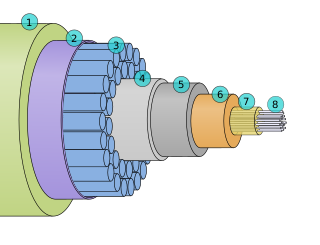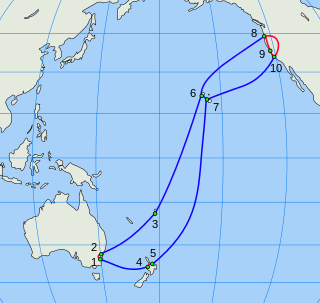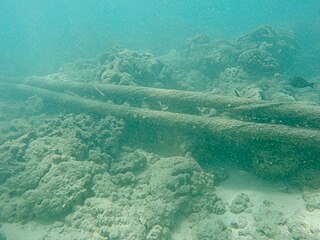Related Research Articles
This article is about communications systems in French Polynesia.
TAT-8 was the 8th transatlantic communications cable and first transatlantic fiber-optic cable, carrying 280 Mbit/s between the United States, United Kingdom and France. It was constructed in 1988 by a consortium of companies led by AT&T Corporation, France Télécom, and British Telecom. AT&T Bell Laboratories developed the technologies used in the cable. The system was made possible by optical amplifiers acting as repeaters with advantages over the electrical repeaters of former cables. They were less costly and could be at greater spacing with less need for associated hardware and software. It was able to serve the three countries with a single transatlantic crossing with the use of an innovative branching unit located underwater on the continental shelf off the coast of Great Britain. The cable lands in Tuckerton, New Jersey, USA, Widemouth Bay, England, UK, and Penmarch, France.

A submarine communications cable is a cable laid on the sea bed between land-based stations to carry telecommunication signals across stretches of ocean and sea. The first submarine communications cables laid beginning in the 1850s carried telegraphy traffic, establishing the first instant telecommunications links between continents, such as the first transatlantic telegraph cable which became operational on 16 August 1858. Subsequent generations of cables carried telephone traffic, then data communications traffic. Modern cables use optical fibre technology to carry digital data, which includes telephone, Internet and private data traffic.

Oahu, also known as "The Gathering Place", is the third-largest of the Hawaiian Islands. It is home to roughly one million people—about two-thirds of the population of the U.S. state of Hawaii. The island is within Honolulu County and the state capital, Honolulu, is on Oahu's southeast coast.

The Southern Cross Cable is a trans-Pacific network of telecommunications cables commissioned in 2000. The network is operated by the Bermuda-registered company Southern Cross Cables Limited.
Hawaiian Telcom, Inc., is the incumbent local exchange carrier (ILEC) or dominant local telephone company, serving the state of Hawaii. In 2005, Hawaiian Telcom Holdco, Inc., was formed by The Carlyle Group, following its purchase of the Hawaiian Telecom Inc. assets of Verizon Communications. On July 2, 2018, Cincinnati Bell purchased Hawaiian Telcom Holdco, Inc. for $650 Million,
The Americas Region Caribbean Ring System (ARCOS-1) is a fiber optic submarine communications cable of 8,400 kilometers that extends between the United States, the Bahamas, the Turks and Caicos Islands, the Dominican Republic, Puerto Rico, Curaçao, Venezuela, Colombia, Panama, Costa Rica, Nicaragua, Honduras, Guatemala, Belize, and Mexico. Because of its length, it was divided in two phases: Phase 1 being in service since September 2001 and Phase II since March 2002. The cable system was set in a ring configuration and is operated on a non-common carrier basis.
TPC-5CN or Trans-Pacific Cable 5 Cable Network is a submarine telecommunications cable system linking Japan, Guam, Hawaii and mainland United States.
G-P is a submarine telecommunications cable system in the North Pacific Ocean linking the two named territories.
Pacific LightNet is a locally owned, facilities-based CLEC, providing both voice and data services to its customers in Hawaii. At the core of its products and services is a 10,000 fiber mile submarine and terrestrial fiber optic network connecting the state's six major islands, the only of its kind. Linked to all major submarine cable landing stations throughout Hawaii, the network provides capacity and services to the mainland and the Pacific Rim.

COLUMBUS II is an optical, repeatered, transatlantic telephone cable. It is approximately 12,102 km in length. It entered into commercial service in 1994. The system, along with the Americas cable, was the first to use the Erbium-doped fiber amplifier (EDFA) as its optical amplifier repeaters.

Telecommunications Engineering is an engineering discipline centered on electrical and computer engineering which seeks to support and enhance telecommunication systems. The work ranges from basic circuit design to strategic mass developments. A telecommunication engineer is responsible for designing and overseeing the installation of telecommunications equipment and facilities, such as complex electronic switching systems, and other plain old telephone service facilities, optical fiber cabling, IP networks, and microwave transmission systems. Telecommunications engineering also overlaps with broadcast engineering.

ECFS is a network of repeaterless fiber optic submarine communications cable that interconnects fourteen (14) eastern Caribbean islands. The cable is 1730 km in length and runs from the British Virgin Islands to Trinidad in ten (10) segments. It was first installed in September 1995 and was scheduled to be upgraded by Xtera Communications as of April 25, 2013.
Hics or HICS may refer to:
This article is about communications systems in American Samoa.
TRANSPAC or Trans-pacific cable (TPC) is a series of undersea cables under the Pacific Ocean.

HAW-1 was the first submarine telephone cable laid between Hawaii and the mainland United States. HAW-1 was laid in 1957, and consisted of two cables,, each carrying 36 channels, with an individual length of 2,625 Nmi (4,862 km) each. The cable originates in Hanauma Bay, Oahu, Hawaii and lands at Point Arena, California.
BDSNi is a fiber optic submarine communications cable system that links the islands of the Bahamas, and also provides connectivity to Haiti via a spur connection.

Seaborn Networks is a developer, owner, and operator of submarine communications cables. Seaborn is the owner and operator of the Seabras-1 "submarine communications cable" between Brazil and the United States. Seabras-1 is fully operational (2017) and provides the first direct route between Sao Paulo, Brazil, and the United States. The system has branching units installed on certain of its fiber pairs that point towards Virginia Beach (US), Miami (US), St. Croix (US), Fortaleza (Brazil), Cape Town, Rio de Janeiro (Brazil), Brazil South. Seaborn's ARBR subsea system is a fully funded 4-fiber pair, 48Tbit/s system. ARBR will directly connect São Paulo, Brazil to Buenos Aires, Argentina. ARBR will connect to Seabras-1 in Seaborn's Praia Grande CLS enabling the most direct, lower latency connection between Argentina and the USA. Partners Group is providing full project equity capital for Seabras-1 and development capital was provided by Seaborn. Seabras-1 is owned jointly by Seaborn Networks and Partners Group. The US$520 million project funding for Seabras-1 has been completed. The project funding also includes a total project debt commitment of up to US$267 million provided by Natixis, Banco Santander, Commerzbank, and Intesa Sanpaolo, which debt is backed by COFACE, the French Export Credit Agency. Seabras-1 is the first direct point-to-point submarine cable system between the financial centers of the US and Brazil.
Alaska United Fiber Optic Cable System is a submarine fiber optic cable owned by GCI that links Anchorage, several places in Southeast Alaska including Juneau, to Oregon and Washington State. Alaska United East (AU-East) is 3,751 kilometers long with landing points at Anchorage and Lena Point in Juneau, and at the shore of Puget Sound at Norma Beach near Picnic Point in Lynnwood, Washington; AU-West has landings at Seward and on the Pacific coast at Warrenton, Oregon. Both are OC-192 rated as of 2018. Additional overland segments (AU-North/NW) connect Anchorage to Fairbanks and Prudhoe Bay along the Alaska Pipeline corridor and Parks Highway.